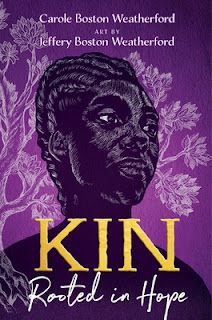AUTHOR & ILLUSTRATOR GUEST POST: KIN: Rooted in Hope by Carole Boston Weatherford, art by Jeffery Boston Weatherford
I call their names:
Abram Alice Amey Arianna Antiqua
I call their names:
Isaac Jake James Jenny Jim
Every last one, property of the Lloyds,
the state’s preeminent enslavers.
Every last one, with a mind of their own
and a story that ain’t yet been told.
Till now.
Carole and Jeffery Boston Weatherford’s ancestors are among the founders of Maryland. Their family history there extends more than three hundred years, but as with the genealogical searches of many African Americans with roots in slavery, their family tree can only be traced back five generations before going dark. And so from scraps of history, Carole and Jeffery have conjured the voices of their kin, creating an often painful but ultimately empowering story of who their people were in a breathtaking book that is at once deeply personal yet all too universal.
Carole’s poems capture voices ranging from her ancestors to Frederick Douglass to Harriet Tubman to the plantation house and land itself that connects them all, and Jeffery’s evocative illustrations help carry the story from the first mention of a forebear listed as property in a 1781 ledger to he and his mother’s homegoing trip to Africa in 2016. Shaped by loss, erasure, and ultimate reclamation, this is the story of not only Carole and Jeffery’s family, but of countless other Black families in America.
By Carole & Jeffery Boston Weatherford
How far back can you trace your lineage? For African-Americans in search of roots, the genealogical clues often run cold before 1870, the first census to list those who had been enslaved by name rather than as property. In KIN: Rooted in Hope, Jeffery and I trace our family’s lineage to 1770—to my fourth great grandparents Isaac and Nancy Copper, who were only children then.
That children were enslaved is reason enough for today’s students to learn about enslavement. But I write about enslavement because an estimated 10 million African descendants were enslaved in colonial America and the U.S. Yet, most have been erased. That’s a lot of lost names and lost narratives.
To reconstruct those narratives, we consulted enslavers’ ledgers, slave ship databases, military records, material culture, the landscape and local lore. We dug deep and discovered subjects and objects rich in story. Through multi-voiced poems and striking scratchboard art, KIN shines a light on the lives of our enslaved ancestors and their community. First-person poems share perspectives from Frederick Douglass, Harriet Tubman, Francis Scott Key and even a hunting dog. KIN follows our ancestors from enslavement to emancipation to the founding of all-Black, Reconstruction-era villages.
Before beginning this quest, we visited West Africa. For us, it was the trip of a lifetime, even more so because we traveled together. When we stood on the Gold Coast looking out at the Atlantic, we thought of our ancestors who were ripped from these shores never to see the Motherland again. We wish we knew their names, their stories. Imagining, speculating, is the closest that we can come to the truth.
The earliest ancestor whom we could identify was Isaac Copper (born c. 1760 or 1763), my fourth great grandfather. This poem is written in his voice.
Click here to hear the poem read aloud by the author.
REVIEW
This remarkable book resonates with truth, heartbreak, and hope. Weatherford takes readers with her on her journey to discover her heritage. But with slavery playing a key role in the lives of her ancestors, she's only able to trace her lineage back to 1770 and a man named Isaac Copper. Through beautiful poetry the people, places, and circumstances her ancestors experienced are highlighted. Some of the poems are from the perspective of individuals such as Frederick Douglass who lived on the same plantation as Isaac Copper for a brief time, and others are told from the perspective of inanimate objects such as a slave ship. Other poems share some of the experiences that Weatherford had as she searched for her family. Weatherford's son, Jeffery, created the stunning scratchboard illustrations that jump off the page. They beautifully compliment the poetry. The book portrays slavery with all it's heartbreak and sorrow while still highlighting the spirit and soul of those who experienced it. But Weatherford doesn't pull any punches and the result is a book well-worth discussing with others, especially young readers not familiar with the realities of slavery and the long-term consequences that still play out today. A powerful, eye-opening book presented in a inspired combination of poetry and art.
ADDITIONAL ILLUSTRATIONS




.jpg)
.png)





Comments
Post a Comment